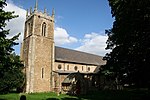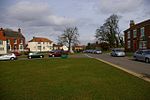Messingham
Civil parishes in LincolnshireUse British English from January 2014Villages in the Borough of North Lincolnshire

Messingham is a village and civil parish in North Lincolnshire, England. The village is situated on the A159, 4 miles (6 km) south from the centre of Scunthorpe and 1 mile (1.6 km) south from the M180. West Lindsey is 1 mile to the south, as is Scotter. Messingham has a population of over 4,000 people, falling to 3,718 at the 2011 census.
Excerpt from the Wikipedia article Messingham (License: CC BY-SA 3.0, Authors, Images).Messingham
High Street,
Geographical coordinates (GPS) Address Nearby Places Show on map
Geographical coordinates (GPS)
| Latitude | Longitude |
|---|---|
| N 53.52727 ° | E -0.65346 ° |
Address
Horn Inn
High Street 77
DN17 3NU , Messingham
England, United Kingdom
Open on Google Maps







